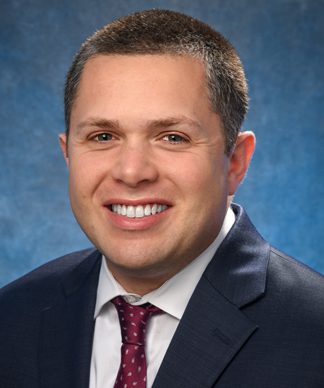When it comes to men’s health, that old, “no pain, no gain,” mindset doesn’t cut it anymore. Here’s what you need to know.
Injuries

Merrick Wetzler, MD
If there’s one common theme among the men who go to South Jersey Orthopedic Associates, it’s that they’re “letting their mind cash a check their body isn’t ready for,” says orthopedic surgeon Merrick Wetzler, MD.
“I start to see men in their 40s, 50s and 60s come into my office with aches and pains from activities that never would have bothered them in their 20s or 30s, but now they’re older and they think they can jump right back into them as if no time has passed,” says Wetzler. “It’s a big mistake.”
The problem, he says, is that men often throw themselves into these activities without proper training, warming up first or giving themselves enough rest afterward.
“A lot of patients grew up playing sports and want to continue those same activities on the weekends, even though their daily activities and bodies have changed a lot since then,” he says. “I also see a lot of overuse injuries – knee pain, shoulder pain, ligament tears and muscle inflammation – from manual labor that wears down the joints over time.”
The best case scenario, he says, is to protect your muscles, joints and bones from injury in the first place. Ease back into activities instead of trying to pick up where you left off, and make sure to incorporate at least 10 minutes of warm-ups and cool-downs to avoid straining the muscles. Focus on strengthening the body overall with cross-training activities like yoga and a generalized lifting program.
“Remember – you can’t just go out and do the same thing you did 20 years ago,” Wetzler says. “You have to start slowly. Work your way up, get back in shape, and then proceed with caution.”
Some aches and pains are normal as men age, but when the pain becomes chronic (meaning it lasts for more than a few weeks) or it severely limits your range of motion, affects your sleep or impacts your daily life, it’s time to see a doctor.
Treatment

Sean Sussman, DO
The biggest misconception in managing pain is that it’s a one-and-done situation, says Sean Sussman, DO, a family medicine physician at Inspira Health. Instead, pain management is a process that brings in new treatments or developments along the way.
“I always start by asking for the patient’s story as a whole, not just the current pain,” he says. “I assess for different kinds of muscle imbalances, weaknesses and instabilities that may be causing the issue, even if it seems unrelated on the surface.”
Once the pain is diagnosed, the conversation turns to treatment.
“I look for ways to address pain non-operatively whenever possible,” he says. “If the pain is relatively low, we can try to treat it with over-the-counter medicines, anti-inflammatories, topical gels that are closer to the surface and injection options like steroids.”
Patients also often benefit from comprehensive programs to strengthen different areas of the body, such as custom exercise programs, physical therapy, osteopathic manipulation, enhanced diet or even acupuncture.
“Think of the body as a system of pulleys. It’s important to maintain a balance across the entire body to protect each individual aspect,” says Sussman. “If your hamstrings are too tight, your core isn’t strong, you have some nutritional deficiency or a lingering injury, that can cause symptoms in other parts of the body.”
If initial efforts don’t work, there’s room for more testing to identify a bigger injury or even degenerative disease. X-rays allow doctors to look at the bones and space between the bones, while an MRI gives a more comprehensive look at the bones, joints and tendons.
“Pain is an ongoing process, which is why it’s really important to have a physician that you trust to work through it,” says Sussman. “Pain can be physically and emotionally challenging, and you need a doctor who is willing to go through the extra steps to diagnose the issue.”
“Pain can be physically and emotionally challenging, and you need a doctor who is willing to go through the extra steps to diagnose the issue.”
Overall health

Perry Weiner, DO
There is, however, one area of men’s pain that often sends men running to the doctor without a second thought.
“Often, urological issues come with enough pain to bring a man to his knees,” says Perry Weiner, DO, a Jefferson Health–New Jersey urologist and director of the hospital’s Men’s Health Program.
Acute pain, such as kidney stones and infections, can be agonizing and require urgent medical or surgical intervention. When pain comes around and sticks around, the chronic symptoms often point to a different diagnosis.
“One common root of chronic pain often arises from prostatitis – inflammation of the prostate,” says Weiner. “It can happen to men at any age, but particularly in their 20s and 30s as their prostate continues to grow, causing discomfort primarily in the groin area, perineum, and can even radiate to the back or legs.”
Managing this pain often involves a combination of antibiotics, anti-inflammatories and dietary adjustments, as well as avoiding inflammatory substances like caffeine and alcohol.
“As men age and the prostate is at its largest, they may experience issues like difficulty with urination, which can cause pain and make it hard to completely empty the bladder, leaving room for the urine to become infected,” he says.
Since urological problems aren’t exactly locker room talk, says Weiner, it’s important for men to have a relationship with a urologist.
“Men should view their urologist just as women traditionally regard their gynecologist,” he says. “Urologists have expertise in addressing intimate health concerns that men may not readily confide in their primary care doctor.”
While primary care physicians focus on managing conditions like diabetes, hypertension, and colonoscopy screenings, urologists can delve deeper into specific urological issues that can significantly impact overall health.
“Men tend to think they’re indestructible, and they ignore pain that can be managed before it becomes too serious of an issue,” says Weiner. “We have to change that mindset.”














